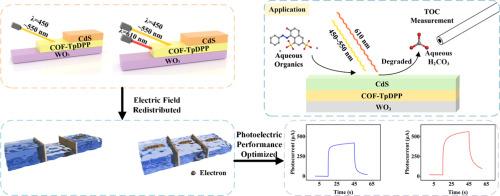The coordination of thermoelectric and photoelectric effects through tailoring the heat-driven electric field revealed by a “ship-lock”-based thermoelectric material
IF 14.3
1区 材料科学
Q1 MATERIALS SCIENCE, MULTIDISCIPLINARY
引用次数: 0
Abstract
The thermoelectric materials could play a crucial role in fuel production for a circular economy, as they could provide a method to utilize the photons of relatively low energy from thermalization losses of light absorption. However, the traditional thermoelectric property was enhanced through optimizing the inherent band engineering according to the Seebeck coefficient, which ignored the off-centering behavior of the conduction band under the light. Herein, we exploited the thermal conversion characteristics of covalent organic framework-1,3,5-triformylphloroglucinol 3,8-diamino-6-phenylphenanthridine (COF-TpDPP) under red light to construct a three-component photoelectric material (WO3/COF-TpDPP/CdS). Through the Kelvin probe force microscope and density functional theory calculations, the COF-TpDPP layer reduced carrier transport barriers under the illumination of red light through the off-centering behavior of the conduction band to form thermoelectric and band-gap compression effects. As a result, the COF-TpDPP facilitated carrier transport between WO3 and CdS by utilizing its thermoelectric properties to reconstruct the carrier migration pathway, thereby creating a heat-mediated charge transfer system analogous to a “ship-lock” mechanism, which caused a 30% enhancement in photocurrent. Additionally, the photocatalytic degradation capability of WO3/COF-TpDPP/CdS has been utilized to develop a device for measuring soluble total organic carbon. This new mechanism presents approaches for the design of advanced thermoelectric materials in enhancing photo-electrocatalytic efficiency for the application in energy management, the treatment of hazardous waste, and environmental monitoring.

一种基于“船闸”的热电材料揭示了通过剪裁热驱动电场来协调热电和光电效应
热电材料可以在循环经济的燃料生产中发挥至关重要的作用,因为它们可以提供一种利用光吸收的热化损失中能量相对较低的光子的方法。然而,传统的热电性能是通过根据塞贝克系数优化固有带工程来增强的,忽略了导带在光作用下的偏离中心行为。本文利用共价有机骨架-1,3,5-三甲酰基间苯三醇3,8-二氨基-6-苯基菲三啶(COF-TpDPP)在红光下的热转化特性,构建了一种三组分光电材料(WO3/COF-TpDPP/CdS)。通过开尔文探针力显微镜和密度泛函理论计算,COF-TpDPP层在红光照射下通过导带偏离中心的行为降低载流子输运垒,形成热电和带隙压缩效应。结果,COF-TpDPP利用其热电性质重建载流子迁移路径,促进了WO3和CdS之间的载流子迁移,从而创建了类似于“船锁”机制的热介导电荷转移系统,从而使光电流增强30%。此外,利用WO3/COF-TpDPP/CdS的光催化降解能力,开发了一种测量可溶性总有机碳的装置。这种新机制为设计先进的热电材料提供了途径,以提高光电催化效率,应用于能源管理、危险废物处理和环境监测。
本文章由计算机程序翻译,如有差异,请以英文原文为准。
求助全文
约1分钟内获得全文
求助全文
来源期刊

Journal of Materials Science & Technology
工程技术-材料科学:综合
CiteScore
20.00
自引率
11.00%
发文量
995
审稿时长
13 days
期刊介绍:
Journal of Materials Science & Technology strives to promote global collaboration in the field of materials science and technology. It primarily publishes original research papers, invited review articles, letters, research notes, and summaries of scientific achievements. The journal covers a wide range of materials science and technology topics, including metallic materials, inorganic nonmetallic materials, and composite materials.
 求助内容:
求助内容: 应助结果提醒方式:
应助结果提醒方式:


